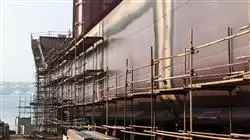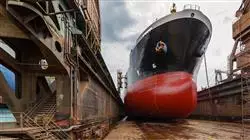University certificate
The world's largest faculty of engineering”
Introduction to the Program
Shipbuilding is a constantly evolving sector that requires qualified professionals qualified in the use of the latest tools in the field”

The Postgraduate diploma in Shipbuilding is a program of the highest academic level that aims to educate professionals in the field, enabling them to carry out their work with the highest quality and safety requirements. It is a very complete program, imparted by professionals with years of experience, and which includes the latest advances in the field.
The program will serve as a tour of the methodology to be followed in calculating structures in Shipbuilding, taking into account the two calculation methods currently in use, namely, rule-based design and direct numerical simulation design. It is essential to understand every vessel is different, subjected to different stresses and classified under different typology, so no two ships will be the same, not even sister ships, which are the closest in similarity. This makes Shipbuildinga form of protocol Engineering in which each structural calculation is unique for each type of vessel.
An important part of the program is directed towards the basic engineering of facilities, machinery and electricity in naval vessel or craft projects. This section is of vital importance to any project, both for professionals in naval engineering of armament and machinery, as knowledge of which will be updated, and for anyone working in any sector in the industry, as knowledge of the core of the facilities on board will be covered, all of which will qualify professionals and strengthen their profiles for this particular niche in the field.
Aspects of Detailed Engineering will also be discussed starting from Basic Engineering, with the aim of developing the necessary technical information for the production phase of a Shipbuilding project. This section will be based on the use of current 3D modeling technologies and design tools used in Detailed Engineering, and their impact on the efficiency of a vessel's construction phase, ranging from hull shapes to virtual reality and its use in PLM systems. Finally, this program aims to reinforce student knowledge in the fields related to ship production and repair, emphasizing the different disciplines, specialties and latest trends in shipyard production and organization.
It should be noted that as this is a 100% online Postgraduate diploma, the student is not conditioned by fixed schedules or the need to move to another physical location, but can access the contents at any time of the day, balancing their work or personal life with their academic life.
The completion of this Postgraduate diploma will place naval Engineering professionals at the forefront of the latest developments in the sector”
This Postgraduate diploma in Shipbuildingcontains the most complete and up-to-date program on the market. The most important features include:
- Case studies presented by experts in naval Engineering
- The graphic, schematic, and practical contents with which they are created, provide scientific and practical information on the disciplines that are essential for professional practice
- Practical exercises where self-assessment can be used to improve learning
- Special emphasis on innovative methodologies in Shipbuilding
- Theoretical lessons, questions to the expert, debate forums on controversial topics, and individual reflection assignments
- Content that is accessible from any fixed or portable device with an Internet connection
This Postgraduate diploma is the best investment you can make in selecting a refresher program in the field of Naval Engineering. We offer you quality and free access to content"
The teaching staff includes professionals in Naval Engineering, who bring their experience to this training program, as well as renowned specialists from leading societies and prestigious universities.
The multimedia content, developed with the latest educational technology, will provide the professional with situated and contextual learning, i.e., a simulated environment that will provide immersive specialization programmed to learn in real situations.
This program is designed around Problem-Based Learning, whereby the professional must try to solve the different professional practice situations that arise throughout the program. To that end, students will have the help of an innovative, interactive video system made by recognized and extensively experienced university experts in Shipbuilding.
This program has the best didactic material, which will enable a contextual study that will facilitate your learning"

This 100% online Postgraduate diploma will allow you to combine your studies with your professional work. You choose where and when to train"
Why study at TECH?
TECH is the world’s largest online university. With an impressive catalog of more than 14,000 university programs available in 11 languages, it is positioned as a leader in employability, with a 99% job placement rate. In addition, it relies on an enormous faculty of more than 6,000 professors of the highest international renown.

Study at the world's largest online university and guarantee your professional success. The future starts at TECH”
The world’s best online university according to FORBES
The prestigious Forbes magazine, specialized in business and finance, has highlighted TECH as “the world's best online university” This is what they have recently stated in an article in their digital edition in which they echo the success story of this institution, “thanks to the academic offer it provides, the selection of its teaching staff, and an innovative learning method aimed at educating the professionals of the future”
A revolutionary study method, a cutting-edge faculty and a practical focus: the key to TECH's success.
The most complete study plans on the university scene
TECH offers the most complete study plans on the university scene, with syllabuses that cover fundamental concepts and, at the same time, the main scientific advances in their specific scientific areas. In addition, these programs are continuously being updated to guarantee students the academic vanguard and the most in-demand professional skills. In this way, the university's qualifications provide its graduates with a significant advantage to propel their careers to success.
TECH offers the most comprehensive and intensive study plans on the current university scene.
A world-class teaching staff
TECH's teaching staff is made up of more than 6,000 professors with the highest international recognition. Professors, researchers and top executives of multinational companies, including Isaiah Covington, performance coach of the Boston Celtics; Magda Romanska, principal investigator at Harvard MetaLAB; Ignacio Wistumba, chairman of the department of translational molecular pathology at MD Anderson Cancer Center; and D.W. Pine, creative director of TIME magazine, among others.
Internationally renowned experts, specialized in different branches of Health, Technology, Communication and Business, form part of the TECH faculty.
A unique learning method
TECH is the first university to use Relearning in all its programs. It is the best online learning methodology, accredited with international teaching quality certifications, provided by prestigious educational agencies. In addition, this disruptive educational model is complemented with the “Case Method”, thereby setting up a unique online teaching strategy. Innovative teaching resources are also implemented, including detailed videos, infographics and interactive summaries.
TECH combines Relearning and the Case Method in all its university programs to guarantee excellent theoretical and practical learning, studying whenever and wherever you want.
The world's largest online university
TECH is the world’s largest online university. We are the largest educational institution, with the best and widest online educational catalog, one hundred percent online and covering the vast majority of areas of knowledge. We offer a large selection of our own degrees and accredited online undergraduate and postgraduate degrees. In total, more than 14,000 university degrees, in eleven different languages, make us the largest educational largest in the world.
TECH has the world's most extensive catalog of academic and official programs, available in more than 11 languages.
Google Premier Partner
The American technology giant has awarded TECH the Google Google Premier Partner badge. This award, which is only available to 3% of the world's companies, highlights the efficient, flexible and tailored experience that this university provides to students. The recognition as a Google Premier Partner not only accredits the maximum rigor, performance and investment in TECH's digital infrastructures, but also places this university as one of the world's leading technology companies.
Google has positioned TECH in the top 3% of the world's most important technology companies by awarding it its Google Premier Partner badge.
The official online university of the NBA
TECH is the official online university of the NBA. Thanks to our agreement with the biggest league in basketball, we offer our students exclusive university programs, as well as a wide variety of educational resources focused on the business of the league and other areas of the sports industry. Each program is made up of a uniquely designed syllabus and features exceptional guest hosts: professionals with a distinguished sports background who will offer their expertise on the most relevant topics.
TECH has been selected by the NBA, the world's top basketball league, as its official online university.
The top-rated university by its students
Students have positioned TECH as the world's top-rated university on the main review websites, with a highest rating of 4.9 out of 5, obtained from more than 1,000 reviews. These results consolidate TECH as the benchmark university institution at an international level, reflecting the excellence and positive impact of its educational model.” reflecting the excellence and positive impact of its educational model.”
TECH is the world’s top-rated university by its students.
Leaders in employability
TECH has managed to become the leading university in employability. 99% of its students obtain jobs in the academic field they have studied, within one year of completing any of the university's programs. A similar number achieve immediate career enhancement. All this thanks to a study methodology that bases its effectiveness on the acquisition of practical skills, which are absolutely necessary for professional development.
99% of TECH graduates find a job within a year of completing their studies.
Postgraduate Diploma in Shipbuilding
.
Dive into the exciting field of shipbuilding and become an expert in ship design, construction and maintenance with our Postgraduate Diploma in Shipbuilding program. At TECH Global University, we understand the importance of acquiring solid, up-to-date knowledge in this ever-evolving field.
.
Enroll now and start in online mode
.
Our Postgraduate Diploma in Shipbuilding program is taught online, giving you the flexibility to study from anywhere and adapt it to your schedule. At TECH Global University, we strive to provide you with a quality, practical education that prepares you for the challenges of the maritime industry. In this program, you will explore the fundamentals of shipbuilding, from conceptual design to production and assembly of vessels. You will learn about the materials used in shipbuilding, assembly techniques, the hydrodynamics and stability of vessels, as well as the regulations and quality standards applied in the industry. Our team of expert teachers will guide you through interactive modules, case studies and practical projects that will allow you to apply your knowledge in real situations. In addition, you will have access to state-of-the-art tools and software used in the marine industry. Upon completion of the Postgraduate Diploma in Shipbuilding program, you will be prepared to work in shipyards, ship design companies, marine engineering companies and other sectors related to shipbuilding and ship maintenance. You will be able to work as a naval engineer, production supervisor or ship designer. At TECH Global University, we are committed to providing you with a quality education that meets your needs and career goals. Join our educational community and acquire the knowledge and skills necessary to excel in the exciting world of shipbuilding. Enroll in our Postgraduate Diploma program and sail into a successful future!







